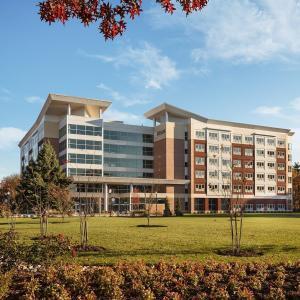Potential students have no shortage of choices for post-secondary education, and ensuring sustainability is part of the campus culture and design is increasingly top of mind.

The benefits of sustainable design on campuses are numerous. For operators, standouts include reducing energy costs and increasing lifespan of a building. For students, introducing elements like biophilic design, as well as fostering connections with the campus community, can boost wellbeing and creativity.
HMC Architects states passive design strategies such as daylighting, natural ventilation and building orientation are some of the simplest and most effective strategies. Active design strategies are important as well. Per a post by Eric Carbonnier, PhD, LEED AP BD+C, Associate Principal, Vice President of Sustainability at the firm:
Active design strategies turn static buildings into dynamic and climatically responsive ones. Facades with operable solar shading and windows, high-efficiency heating and cooling systems, and sensor-optimized daylighting are joined in a heightened cyber dialog balancing exterior conditions, building energy optimization, and occupant comfort and well-being all in real time.
Sustainability does not just reflect design choices; impact on the surrounding community is important as well. Many towns that host universities are greatly impacted by campus presence through both social and economic means. Per Stephen Coulston, principal with Perkins + Will, Austin, Texas for FacilitiesNet:
When implementing new design plans, recognizing that the campus does not exist in a vacuum is crucial, and to that end, it is key to involve members of the community in discussions regarding university goals. Both university and community use the same infrastructure — streets, sidewalks, bridges — to get around, and students, faculty, and staff live in neighborhoods alongside locals. Campuses rely on local utility providers, and businesses near campus rely on student patronage. Furthermore, the university’s efforts towards more sustainable practices can benefit the community, lessening their carbon footprint and ultimately inspiring a more green lifestyle.
A prime example of such a building is Georgia Tech’s Kendeda Building for Innovative Sustainable Design. The building produces more energy than it consumes, despite being situated in an area known for its heat and humidity. During construction, more waste was diverted from landfill than was produced. It includes a rainwater-to-drinking-water treatment system and was built using materials that avoid hazardous chemicals. It also includes a slew of repurposed building materials – including two-by-fours dismantled from movie sets and slate shingles from the roof of a separate campus building used on the walls and floors of showers and restrooms – which are outlined in Architect Magazine.


